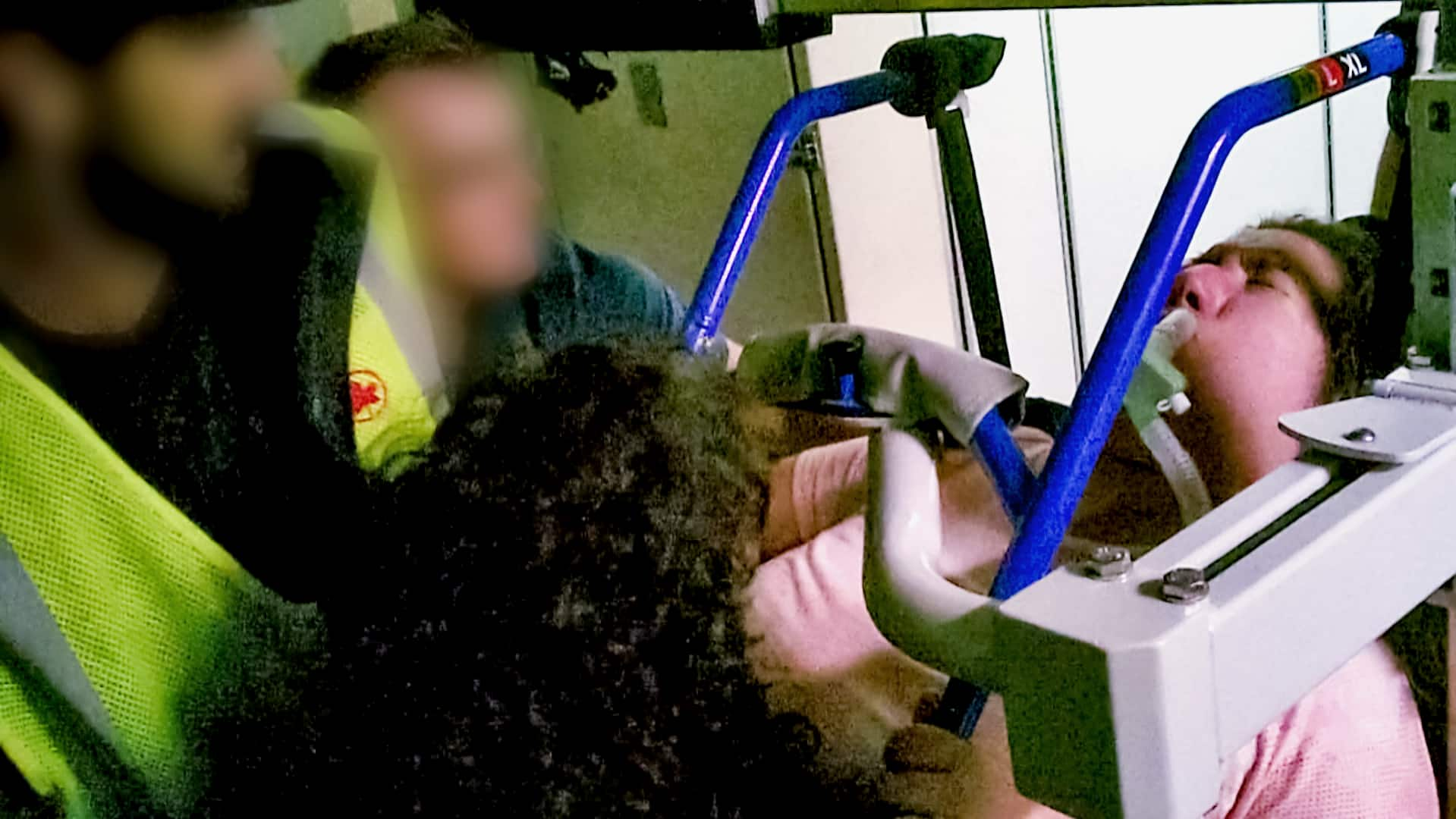Marketplace investigation also found public transit issues for people with disabilities.

Michelle Weger relies on her service dog, Quinn, to get her through the day.
The Ottawa resident has narcolepsy, and the Great Dane can sense when Weger is tired, bracing against her or warning her when she’s about to experience cataplexy, a temporary muscle paralysis that can cause her to fall. That early warning gives Weger the time to get to a safe space.
For Weger, Quinn is an absolute necessity, but can become an issue when she tries to get an Uber, Lyft or taxi. She says there’s been “friction” with drivers and cancelled rides with rideshares.
- You can watch the full investigation, Access Denied, Friday, Nov. 10, at 8 p.m., 8:30 in Newfoundland, on CBC-TV and anytime on YouTube or CBC Gem.
With hidden cameras rolling, CBC’s Marketplace followed Weger as she attempted to hire Uber and Lyft rides in Toronto, as well as local taxis.
Half of the Uber and Lyft drivers were informed in advance that there was a service dog. The rest found out when they arrived.
Three out of six Uber drivers denied service to Weger and Quinn. One driver acknowledged receipt of the message saying Weger was travelling with a service dog, then cancelled about two minutes later. Another arrived for the pick-up and said Weger must request a ride through Uber Pet, a service that costs more than a standard ride.
Uber told Marketplace it believes in equal transportation for all Canadians, and that it reminds drivers of their legal obligations and policy “at several points throughout the year.” It also says its pet service is not required for service dogs.

When one Lyft driver was warned about Weger’s service dog through the app, the driver cancelled shortly after the message was sent.
Lyft told Marketplace they have a strict policy that drivers must accept service dogs, and say they take the issue “very seriously.”
Weger said that while she’s not a heavy rideshare user, the experience “makes me feel very sad for people who need to use rideshare services to be able to get to work or have a social life.”
Marketplace’s test results are indicative of the wider problem of transportation accessibility in Canada for people with disabilities, says Jeff Preston, a professor of disability studies at King’s University College in London, Ont.
While the federal government has set a goal of being “barrier-free” by 2040, Preston says Canadian jurisdictions need to do more to reduce barriers for people with disabilities.
“I think we’re being a little bit too polite, and I think we’re also being a bit too naive in assuming that we’re already doing enough, which quite frankly we’re not,” Preston said.
Challenges abound
Weger’s experience is part of a Marketplace investigation into the challenges people with disabilities face while travelling. The show documented three passengers, who each took different modes of transit, and encountered multiple barriers, which led to increased travel time, discomfort and sometimes outright danger.
Earlier this week, Marketplace told the story of Alessia Di Virgilio, a Toronto woman who uses a wheelchair. She was not only separated from her wheelchair but had her ventilator briefly disconnected and a lift fall on her head during a round trip with Air Canada from Toronto to Charlottetown in August.

Hidden camera catches ‘traumatic’ moment lift falls on passenger’s head when Air Canada staff struggle during the transfer to her wheelchair
Marketplace is releasing an exclusive preview of its hidden camera investigation which documented a rarely seen first-hand account of the challenges faced by those flying with a disability.
Marketplace heard from dozens of people with service dogs who say they have had issues with Uber, Lyft and local taxi companies denying rides.
It’s against the law in Ontario to deny service to someone with a service dog, and there are few circumstances where a driver is allowed to deny a rider, such as a religious exemption or a severe allergy.
Weger understands that not all drivers are comfortable with dogs, and takes steps to soothe concerns from drivers she encounters.
“I always want them to know this is a service dog, so that they know this dog is trained and this dog is safe,” she said.
During the Marketplace test, three Beck cabs were hailed with the dog in plain sight and three Co-op Cabs were called with no warning about Quinn. Out of six attempts, one driver from Beck and one driver from Co-op denied Weger a ride. The driver for Co-op said they had allergies.
Preston says if a driver has an allergy to dogs, a new driver should be sent.
Two other Beck drivers and two other Co-op drivers drove Weger and Quinn without incident. Spokespeople for both companies said they’re “disappointed” by the test results, and have zero tolerance for refusals. Beck added it is “sincerely sorry.”
‘Long way to go’ for Calgary public transit
Peter Quaiattini is an avid adventurer who loves skiing and has even dabbled in ice climbing. The Calgary resident is used to navigating the world with progressive vision loss, but in the last few years, Quaiattini has lost all functional vision.
Inside his home, he ensures his appliances have tactile knobs, his thermometers have audible measurements and his recipes are read aloud through his phone.
Outside his home, he has less control.
“The sidewalks are not predictable, finding bus stops … is tricky, getting on the LRT is anxiety-provoking, losing my way and finding my way again takes a lot of mental effort,” said Quaiattini, who uses a white cane.

Quaiattini volunteers with the City of Calgary on a committee focused on “universal design for people with disabilities,” but when he teamed up with Marketplace to document how he navigates public transit in Calgary, he made it clear it was solely to illustrate his own experience.
One of the issues Quaiattini flagged is that buses lack audible external route announcements. While some major Canadian cities use them, buses in Calgary have no external audible indication of which bus is arriving or where it’s going. Quaiattini says he has to rely on the sound of the brakes to know when the bus is arriving.
Calgary buses have internal stop announcements, but Quaiattini’s journey revealed they’re not always made available. On one bus, Marketplace captured Quaiattini asking the bus driver to turn on the announcements — but the driver couldn’t get them to work.
Preston says it’s “not uncommon” for accessibility features to be turned off.
“It’s presuming that the disabled person is the one with the obligation to request access, as opposed to the service being obligated to provide access whether or not a request has been made,” he said.
‘It’s really my only option’
For Quaiattini, the most stressful part of public transit is the train. Only two of the 45 CTrain stations in Calgary have tactile strips he can follow with his cane at a safe distance from the edge of the platform. (The city is piloting them until 2024, when it will determine whether the strips aided in accessibility.)
Without those strips, Quaiattini says he has to use his cane to determine the edge of the train platform. “It’s really my only option.”
Another concern for Quaiattini is a lack of safe, designated boarding areas for passengers with disabilities. As well, he says you have to press a “Timbit” sized button to open the doors. So Quaiattini has only a short amount of time once a train arrives to run his hand along the train to find the button to open the doors.
“On occasion, I’ve had my hand or white cane caught behind the doors as they slide open — that’s no fun,” he said.

Another danger for Quaiattini is what’s known as a floating bus stop, which is between a bike lane and car traffic. To reach it, Quaiattini must cross the bike lane.
The stops are designed with cyclist safety in mind, but in 2020, the B.C. Human Rights Tribunal found that some stops in Victoria discriminated against people who are blind and may not hear cyclists approaching.
Quaiattini says Calgary is making some good efforts to improve the accessibility of its transit system, but “there’s a long way to go.”
Calgary Mayor Jyoti Gondek agrees.
“I will be going to my colleagues on council,” she told Marketplace. “I will make sure that Peter’s voice is heard and amplified and I will make sure that we are making the decisions we need to in the interest of Calgarians who are facing accessibility issues.”
‘Open up a world for people with disabilities’
Preston said that in Canada, accessibility is legislated at federal, provincial and municipal levels, creating a patchwork of laws across the country and a lack of consistent standards.
Canadians “presume that disabled people are being taken care of in this country, because that’s a fundamental value of this country. The reality, unfortunately, is it couldn’t be further from that.”
He said that setting government goals for accessibility recognizes the need for change, but laws “need to be a lot more proactive than simply ‘let’s make a plan and see how you did over the next three years.’ “

“I’ve had experiences in Europe in very old cities that are far more accessible than things that I’ve experienced here in Canada,” Preston said.
He pointed out that adding accessibility features makes things easier for everyone, not just those with disabilities. For example, automatic doors are helpful for people with their hands full or pushing large strollers, and audible announcements are helpful for anyone not familiar with the service.
He is calling on governments to issue harsher fines to transit providers that are not accessible, and develop better accessibility standards that “actually open up a world for people with disabilities.”
“Disabled people in Canada have decided that we’re sick and tired of being left out in the cold,” he said. “We’re ready to be full Canadians, but we need your help.”
ABOUT THE AUTHOR
Jenny Cowley is an investigative journalist in Toronto. She has previously reported for CBC in Nova Scotia. You can reach her at Jenny.cowley@cbc.ca.
*****
Credit belongs to : www.cbc.ca
 Atin Ito First Filipino Community Newspaper in Ontario
Atin Ito First Filipino Community Newspaper in Ontario






